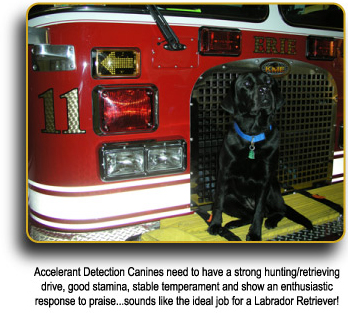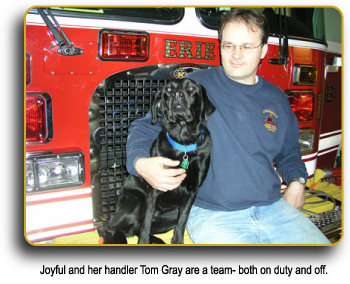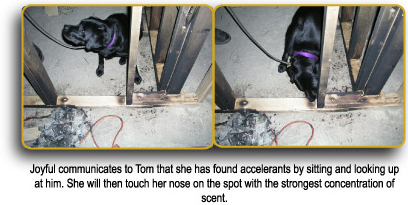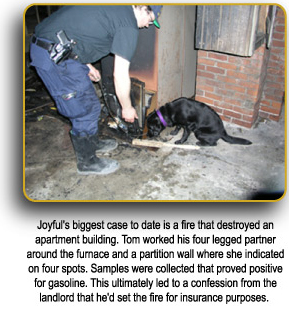


Christmas Store
The holidays are just around the corner so now is the time to fetch the finest gifts for the Labrador Lover on your Christmas list. We have over 100 gifts $50.00 and under. Visit our Christmas Store.
For the Lab
Bedding
Coats
Collars and Leads
Dog Bowls
Feeding Stations
Spa and Grooming
Toys and Treats
Travel and Accessories
For the Lab Lover
Apparel
Cards and Giftwrap
Fine Accessories
Gifts and All Occasions
Jewelry
Kids Only
For the Lab Home
Artwork
Books
Garden and Outdoor
Home Furnishings
Kitchen Accessories
Pillows, Throws, and Rugs
Gift ServicesGift Boxes
Gift Certificates
Arson: Cause for Paws
By Ellen English
 Born at the Guide Dog Foundation in Smithtown, NY as part of their in-house breeding program, Joyful was supposed to grow up to assist the sight impaired. Instead, she assists the olfactory impaired humans who are sent to investigate suspicious fires. With a sense of smell estimated to be close to 100 times better than that of a human, Joyful, like other Accelerant Detection Canines, can detect the evidence of a possible arson with a precision that even the most sophisticated equipment has failed to duplicate.
Born at the Guide Dog Foundation in Smithtown, NY as part of their in-house breeding program, Joyful was supposed to grow up to assist the sight impaired. Instead, she assists the olfactory impaired humans who are sent to investigate suspicious fires. With a sense of smell estimated to be close to 100 times better than that of a human, Joyful, like other Accelerant Detection Canines, can detect the evidence of a possible arson with a precision that even the most sophisticated equipment has failed to duplicate.
Her full name, Second Sight Joyful, was chosen by a participant in the Foundations Dog Sponsorship program which allows benefactors who donate $6000 or more to name a puppy. At 7 weeks of age, Joyful was placed with a family of puppy raisers for about a year to receive socialization and basic obedience training. Once she returned to the Foundation for evaluation, it was determined that her highly inquisitive nature could be a problem for a blind person on the end of a harness. It did however make her a great candidate for a working dog.
Like many other dogs from the Foundation who don't meet the strict criteria for a guide dog, Joyful was offered to the Connecticut State Police whose Accelerant Detection K-9 Training Program is considered one of the premiere programs in the country. In the mid 1980's, several agents from the Bureau of Alcohol, Tobacco & Firearms (ATF) started to research the possibility of using dogs to detect the presence of flammable liquid residues at fire scenes. They knew dogs were proficient in detecting drugs and explosives, so why not accelerants (flammable liquids) that may have been used in cases of arson? Through a collaborative effort between the ATF, the New Haven State's Attorney's Office, the Connecticut State Police (CSP) Forensic Science Lab, the Bureau of the State Fire Marshal, and the Emergency Services Division's K-9 Unit, the CSP launched its first training program May 1, 1986. The programs first trainee, Mattie, was, like Joyful, a black female Labrador Retriever. Tests proved that Mattie could detect 17 different odors and this pioneering Lab went on to become the world's first certified Accelerant Detection Canine.
Joyful spent two intensive months in this renowned training program that uses a strict food reward system. Rather than being fed a bowl of food for dinner like most dogs, these dogs earn their kibble throughout the day during training sessions. A daisy wheel or training wheel (imagine a wagon wheel lying on its side with a can attached to the end of each spoke) is set up to teach the dogs to differentiate among substances that are typically found on a fire scene. Trainers use 3 pound coffee cans filled with debris from fire scenes (soaps, blood, skin, burned foam rubber, etc.) to imprint the desired substances on the dog. One of the cans will contain a drop or two of accelerant in it and when the dog investigates that can, they are immediately rewarded with a few pieces of dog food. If they're interested in an odor that's not an accelerant, they aren't rewarded. They quickly learn to associate the smell of accelerants with food and their job in life then becomes finding traces of gas or other flammable liquids. A lot of the scents are close, since some items like polyurethane plastics and foam rubber cushions will chemically change in a fire and the scents are almost identical to gas. No one's sure exactly how they do it, but somehow the dogs discern the difference.
 During her second month, Joyful was paired up with Tom Gray, an Erie, Pennsylvania arson investigator, to train together as a team. It's at this point that the dogs are taught an indication or alert to signal the handler that theyve found an accelerant. They are taught a passive alert position, sitting and pointing with their noses, so as not to disturb any evidence at a fire scene. As training progresses, the dogs are exposed to several different fuels such as lacquer thinner, Coleman fuel, diesel, gas and charcoal lighter fluid. Depending on the maturity of the dog, some of them will alert on 20 different things. Handlers begin hiding a drop or two along baseboards, in cracks in cement, on stairways or in chipped asphalt to prepare the dog for the many types of terrain that they may encounter at actual fire scenes.
During her second month, Joyful was paired up with Tom Gray, an Erie, Pennsylvania arson investigator, to train together as a team. It's at this point that the dogs are taught an indication or alert to signal the handler that theyve found an accelerant. They are taught a passive alert position, sitting and pointing with their noses, so as not to disturb any evidence at a fire scene. As training progresses, the dogs are exposed to several different fuels such as lacquer thinner, Coleman fuel, diesel, gas and charcoal lighter fluid. Depending on the maturity of the dog, some of them will alert on 20 different things. Handlers begin hiding a drop or two along baseboards, in cracks in cement, on stairways or in chipped asphalt to prepare the dog for the many types of terrain that they may encounter at actual fire scenes.
Once the team completed their initial training, the City of Erie made a $2000 donation to the Guide Dog Foundation that allowed them to make Joyful an official member of the Erie Police Department, becoming the city's first dog trained specifically for arson investigations. The team handles all of Erie County, encompassing approximately 75 square miles, and when a fire occurs that is deemed suspicious, Joyful and Tom are called in to determine if accelerants are present. They begin their work with a calibration, which is simply a test to determine that the dog who is about to work the scene is exhibiting their normal detection capabilities on that given day. Tom places drops of gas in an area and tests Joyful's response. This serves to verify, for legal purposes, any evidence that is collected that day. Once they're on the scene of the fire, Joyful is told to go to work and is allowed to do a self directed free search on lead that allows her to go for the most intense area of scent. As Tom explains, whatever she finds on her own will be the strongest. The team will then do a target search where Tom asks Joyful to seek, meaning that she should carefully check out certain areas that he directs her to. If at any point she finds the presence of accelerants, Joyful will sit and look at the food pouch on Toms waist. Tom then says 'show me' and Joyful will touch her nose on a specific area.
 This pinpointing of potential evidence enables investigators to collect fewer, more accurate samples for testing, which in turn saves significant time and money. Some investigators use other methods, such as hydrocarbon detectors (hydrocarbon being the substance most commonly found at an arson fire scene) to take samples but dogs can pinpoint traces that escape electronic detection. A hydrocarbon detection device resembles a flashlight with a wand on it that vacuums in the vapors as you run the device across the floor. It gives a reading that indicates if it's light, medium or heavy fuel but it does not discriminate between normal items made from petroleum products that might have burned in a fire and items that might contain an ignitable liquid. Since today's fire scenes contain a large amount of petroleum based products such as plastics, polyurethane foam chair cushions and carpeting, properly trained Accelerant Detection Dogs are taught to ignore these normal pyrolysis products and concentrate on finding volatile liquids.
This pinpointing of potential evidence enables investigators to collect fewer, more accurate samples for testing, which in turn saves significant time and money. Some investigators use other methods, such as hydrocarbon detectors (hydrocarbon being the substance most commonly found at an arson fire scene) to take samples but dogs can pinpoint traces that escape electronic detection. A hydrocarbon detection device resembles a flashlight with a wand on it that vacuums in the vapors as you run the device across the floor. It gives a reading that indicates if it's light, medium or heavy fuel but it does not discriminate between normal items made from petroleum products that might have burned in a fire and items that might contain an ignitable liquid. Since today's fire scenes contain a large amount of petroleum based products such as plastics, polyurethane foam chair cushions and carpeting, properly trained Accelerant Detection Dogs are taught to ignore these normal pyrolysis products and concentrate on finding volatile liquids.
It can take a long time to search a large area of burn damage with a mechanical sniffer-what might take an hour with a hydrocarbon detection device will probably take only minutes with a good dog like Joyful. And time counts when you're dealing with evidence that dissipates. Although the presence of accelerants does not automatically mean arson has taken place, the location of an accelerant can be a critical clue. Accelerants found in an unusual place, like on a couch or poured around an office desk, are an indication of foul play, Tom explains. Joyful not only helps investigators zero in on specific areas such as these but she can also eliminate the possibility of accelerants which greatly decreases the amount of time it takes an investigator to process the scene.
Another big advantage to using a dog is the ability to prescreen samples before they are sent to a laboratory for analysis. Depending on the situation and other factors such as weather, the samples that have been collected are taken outside of the burned structure and placed in a line-up consisting of at least three other cans of similar fire debris. Joyful is asked to search the line-up and if she alerts to the sample, it is sealed and shipped to a forensic laboratory for analysis. If she does not alert to the sample, investigators go back inside and expand their collection of the sample area. This method has greatly increased laboratory confirmation of submitted samples.
Once the search process is complete, Tom conducts another calibration test on Joyful and the samples that were collected are sent to the Pennsylvania State Crime Lab for detailed analysis. While Joyful's assistance is invaluable, she is but one tool in the investigation process. After Labrador examination, laboratory analysis is key. Basic investigative skills must still be used to determine the origin and cause of the fire and every sample must be analyzed to verify the presence of hydrocarbon residue.
 Since Joyful, like most Accelerant Detection Canines, is only fed when she finds accelerants, training exercises are a twice daily event. She makes about 70 hits a day and gets several pieces of kibble each time...that's how she eats, Tom explains. This food-reward system requires a serious commitment on the part of the handler but it does wonders to maintain her skill level and encourage peak performance. The pair also train four times a year back in Connecticut and must pass a rigorous re-certification test once a year. This re-certification process includes a blind test conducted by a forensic scientist to make sure the dogs alert only on what they're supposed to.
Since Joyful, like most Accelerant Detection Canines, is only fed when she finds accelerants, training exercises are a twice daily event. She makes about 70 hits a day and gets several pieces of kibble each time...that's how she eats, Tom explains. This food-reward system requires a serious commitment on the part of the handler but it does wonders to maintain her skill level and encourage peak performance. The pair also train four times a year back in Connecticut and must pass a rigorous re-certification test once a year. This re-certification process includes a blind test conducted by a forensic scientist to make sure the dogs alert only on what they're supposed to.
As on-scene investigators at any fires of suspicious origin, Tom and Joyful are on call 24 hours a day, seven days a week and have been called out in the middle of the night more than once! They also give public demonstrations at grade schools where Joyful, now 2 years old, is great with children, Tom adds. Off duty, Joyful enjoys her bone shaped tennis ball and lives with Tom and his wife Ruth at their new home situated right on a lake, where the hard working Lab will probably be in the water a lot.
We salute this super sniffing canine and wish her many years of dedicated service in the fight on crime.
Tail End:
To learn more about the Connecticut State Police K-9 Training Program, visit their site.
For more on the guide dog program that Joyful came from, visit the Guide Dog Foundationwebsite.
The Canine Nose Knows!
While most of us are likely to credit our canine partners with a wealth of talents, take a moment to contemplate how truly extraordinary their olfactory abilities are and consequently, how beneficial these abilities are to the law enforcement community:
► Odor Lock: In human beings, the brain decreases or eliminates the stimulus of smell to the brain after about ten to fifteen minutes, regardless of whether that smell has been present for five minutes or five years. Dogs, on the other hand, can lock in odor, making it possible for them to continue working the source for hours at a time.
► Olfactory Direction Location: The human sense of smell is conveyed to the brain by the Olfactory nerve and is generally only capable of detecting that an odor is present, not the direction from which the odor is emanating from. The dog brain is able to discern which nostril has the greatest concentration of odor. If the greater amount of odor is in the dog's left nostril, it knows that whatever it is searching for is off to its left, and visa versa. When the amount of odor is balanced in both nostrils then the animal knows that whatever it is searching for is in front of it. This ability is a tremendous boon to the investigator.
► Odor Layering: When a person first goes into a kitchen where someone is cooking chili, they can smell...well, chili. When a canine goes into the kitchen, it can smell the hamburger, the beans, the tomatoes, the seasonings, etc.-the dog can break the chili into individual layers. This is basically why narcotics dogs are not fooled by coffee grounds or other substances that drug dealers try to hide narcotics in. As long as the odor is present, the dog smells it.
Click here to go back to Lab of the Month
By Ellen English
 Born at the Guide Dog Foundation in Smithtown, NY as part of their in-house breeding program, Joyful was supposed to grow up to assist the sight impaired. Instead, she assists the olfactory impaired humans who are sent to investigate suspicious fires. With a sense of smell estimated to be close to 100 times better than that of a human, Joyful, like other Accelerant Detection Canines, can detect the evidence of a possible arson with a precision that even the most sophisticated equipment has failed to duplicate.
Born at the Guide Dog Foundation in Smithtown, NY as part of their in-house breeding program, Joyful was supposed to grow up to assist the sight impaired. Instead, she assists the olfactory impaired humans who are sent to investigate suspicious fires. With a sense of smell estimated to be close to 100 times better than that of a human, Joyful, like other Accelerant Detection Canines, can detect the evidence of a possible arson with a precision that even the most sophisticated equipment has failed to duplicate.Her full name, Second Sight Joyful, was chosen by a participant in the Foundations Dog Sponsorship program which allows benefactors who donate $6000 or more to name a puppy. At 7 weeks of age, Joyful was placed with a family of puppy raisers for about a year to receive socialization and basic obedience training. Once she returned to the Foundation for evaluation, it was determined that her highly inquisitive nature could be a problem for a blind person on the end of a harness. It did however make her a great candidate for a working dog.
Like many other dogs from the Foundation who don't meet the strict criteria for a guide dog, Joyful was offered to the Connecticut State Police whose Accelerant Detection K-9 Training Program is considered one of the premiere programs in the country. In the mid 1980's, several agents from the Bureau of Alcohol, Tobacco & Firearms (ATF) started to research the possibility of using dogs to detect the presence of flammable liquid residues at fire scenes. They knew dogs were proficient in detecting drugs and explosives, so why not accelerants (flammable liquids) that may have been used in cases of arson? Through a collaborative effort between the ATF, the New Haven State's Attorney's Office, the Connecticut State Police (CSP) Forensic Science Lab, the Bureau of the State Fire Marshal, and the Emergency Services Division's K-9 Unit, the CSP launched its first training program May 1, 1986. The programs first trainee, Mattie, was, like Joyful, a black female Labrador Retriever. Tests proved that Mattie could detect 17 different odors and this pioneering Lab went on to become the world's first certified Accelerant Detection Canine.
Joyful spent two intensive months in this renowned training program that uses a strict food reward system. Rather than being fed a bowl of food for dinner like most dogs, these dogs earn their kibble throughout the day during training sessions. A daisy wheel or training wheel (imagine a wagon wheel lying on its side with a can attached to the end of each spoke) is set up to teach the dogs to differentiate among substances that are typically found on a fire scene. Trainers use 3 pound coffee cans filled with debris from fire scenes (soaps, blood, skin, burned foam rubber, etc.) to imprint the desired substances on the dog. One of the cans will contain a drop or two of accelerant in it and when the dog investigates that can, they are immediately rewarded with a few pieces of dog food. If they're interested in an odor that's not an accelerant, they aren't rewarded. They quickly learn to associate the smell of accelerants with food and their job in life then becomes finding traces of gas or other flammable liquids. A lot of the scents are close, since some items like polyurethane plastics and foam rubber cushions will chemically change in a fire and the scents are almost identical to gas. No one's sure exactly how they do it, but somehow the dogs discern the difference.
 During her second month, Joyful was paired up with Tom Gray, an Erie, Pennsylvania arson investigator, to train together as a team. It's at this point that the dogs are taught an indication or alert to signal the handler that theyve found an accelerant. They are taught a passive alert position, sitting and pointing with their noses, so as not to disturb any evidence at a fire scene. As training progresses, the dogs are exposed to several different fuels such as lacquer thinner, Coleman fuel, diesel, gas and charcoal lighter fluid. Depending on the maturity of the dog, some of them will alert on 20 different things. Handlers begin hiding a drop or two along baseboards, in cracks in cement, on stairways or in chipped asphalt to prepare the dog for the many types of terrain that they may encounter at actual fire scenes.
During her second month, Joyful was paired up with Tom Gray, an Erie, Pennsylvania arson investigator, to train together as a team. It's at this point that the dogs are taught an indication or alert to signal the handler that theyve found an accelerant. They are taught a passive alert position, sitting and pointing with their noses, so as not to disturb any evidence at a fire scene. As training progresses, the dogs are exposed to several different fuels such as lacquer thinner, Coleman fuel, diesel, gas and charcoal lighter fluid. Depending on the maturity of the dog, some of them will alert on 20 different things. Handlers begin hiding a drop or two along baseboards, in cracks in cement, on stairways or in chipped asphalt to prepare the dog for the many types of terrain that they may encounter at actual fire scenes.Once the team completed their initial training, the City of Erie made a $2000 donation to the Guide Dog Foundation that allowed them to make Joyful an official member of the Erie Police Department, becoming the city's first dog trained specifically for arson investigations. The team handles all of Erie County, encompassing approximately 75 square miles, and when a fire occurs that is deemed suspicious, Joyful and Tom are called in to determine if accelerants are present. They begin their work with a calibration, which is simply a test to determine that the dog who is about to work the scene is exhibiting their normal detection capabilities on that given day. Tom places drops of gas in an area and tests Joyful's response. This serves to verify, for legal purposes, any evidence that is collected that day. Once they're on the scene of the fire, Joyful is told to go to work and is allowed to do a self directed free search on lead that allows her to go for the most intense area of scent. As Tom explains, whatever she finds on her own will be the strongest. The team will then do a target search where Tom asks Joyful to seek, meaning that she should carefully check out certain areas that he directs her to. If at any point she finds the presence of accelerants, Joyful will sit and look at the food pouch on Toms waist. Tom then says 'show me' and Joyful will touch her nose on a specific area.
 This pinpointing of potential evidence enables investigators to collect fewer, more accurate samples for testing, which in turn saves significant time and money. Some investigators use other methods, such as hydrocarbon detectors (hydrocarbon being the substance most commonly found at an arson fire scene) to take samples but dogs can pinpoint traces that escape electronic detection. A hydrocarbon detection device resembles a flashlight with a wand on it that vacuums in the vapors as you run the device across the floor. It gives a reading that indicates if it's light, medium or heavy fuel but it does not discriminate between normal items made from petroleum products that might have burned in a fire and items that might contain an ignitable liquid. Since today's fire scenes contain a large amount of petroleum based products such as plastics, polyurethane foam chair cushions and carpeting, properly trained Accelerant Detection Dogs are taught to ignore these normal pyrolysis products and concentrate on finding volatile liquids.
This pinpointing of potential evidence enables investigators to collect fewer, more accurate samples for testing, which in turn saves significant time and money. Some investigators use other methods, such as hydrocarbon detectors (hydrocarbon being the substance most commonly found at an arson fire scene) to take samples but dogs can pinpoint traces that escape electronic detection. A hydrocarbon detection device resembles a flashlight with a wand on it that vacuums in the vapors as you run the device across the floor. It gives a reading that indicates if it's light, medium or heavy fuel but it does not discriminate between normal items made from petroleum products that might have burned in a fire and items that might contain an ignitable liquid. Since today's fire scenes contain a large amount of petroleum based products such as plastics, polyurethane foam chair cushions and carpeting, properly trained Accelerant Detection Dogs are taught to ignore these normal pyrolysis products and concentrate on finding volatile liquids.It can take a long time to search a large area of burn damage with a mechanical sniffer-what might take an hour with a hydrocarbon detection device will probably take only minutes with a good dog like Joyful. And time counts when you're dealing with evidence that dissipates. Although the presence of accelerants does not automatically mean arson has taken place, the location of an accelerant can be a critical clue. Accelerants found in an unusual place, like on a couch or poured around an office desk, are an indication of foul play, Tom explains. Joyful not only helps investigators zero in on specific areas such as these but she can also eliminate the possibility of accelerants which greatly decreases the amount of time it takes an investigator to process the scene.
Another big advantage to using a dog is the ability to prescreen samples before they are sent to a laboratory for analysis. Depending on the situation and other factors such as weather, the samples that have been collected are taken outside of the burned structure and placed in a line-up consisting of at least three other cans of similar fire debris. Joyful is asked to search the line-up and if she alerts to the sample, it is sealed and shipped to a forensic laboratory for analysis. If she does not alert to the sample, investigators go back inside and expand their collection of the sample area. This method has greatly increased laboratory confirmation of submitted samples.
Once the search process is complete, Tom conducts another calibration test on Joyful and the samples that were collected are sent to the Pennsylvania State Crime Lab for detailed analysis. While Joyful's assistance is invaluable, she is but one tool in the investigation process. After Labrador examination, laboratory analysis is key. Basic investigative skills must still be used to determine the origin and cause of the fire and every sample must be analyzed to verify the presence of hydrocarbon residue.
 Since Joyful, like most Accelerant Detection Canines, is only fed when she finds accelerants, training exercises are a twice daily event. She makes about 70 hits a day and gets several pieces of kibble each time...that's how she eats, Tom explains. This food-reward system requires a serious commitment on the part of the handler but it does wonders to maintain her skill level and encourage peak performance. The pair also train four times a year back in Connecticut and must pass a rigorous re-certification test once a year. This re-certification process includes a blind test conducted by a forensic scientist to make sure the dogs alert only on what they're supposed to.
Since Joyful, like most Accelerant Detection Canines, is only fed when she finds accelerants, training exercises are a twice daily event. She makes about 70 hits a day and gets several pieces of kibble each time...that's how she eats, Tom explains. This food-reward system requires a serious commitment on the part of the handler but it does wonders to maintain her skill level and encourage peak performance. The pair also train four times a year back in Connecticut and must pass a rigorous re-certification test once a year. This re-certification process includes a blind test conducted by a forensic scientist to make sure the dogs alert only on what they're supposed to.As on-scene investigators at any fires of suspicious origin, Tom and Joyful are on call 24 hours a day, seven days a week and have been called out in the middle of the night more than once! They also give public demonstrations at grade schools where Joyful, now 2 years old, is great with children, Tom adds. Off duty, Joyful enjoys her bone shaped tennis ball and lives with Tom and his wife Ruth at their new home situated right on a lake, where the hard working Lab will probably be in the water a lot.
We salute this super sniffing canine and wish her many years of dedicated service in the fight on crime.
Tail End:
To learn more about the Connecticut State Police K-9 Training Program, visit their site.
For more on the guide dog program that Joyful came from, visit the Guide Dog Foundationwebsite.
The Canine Nose Knows!
While most of us are likely to credit our canine partners with a wealth of talents, take a moment to contemplate how truly extraordinary their olfactory abilities are and consequently, how beneficial these abilities are to the law enforcement community:
► Odor Lock: In human beings, the brain decreases or eliminates the stimulus of smell to the brain after about ten to fifteen minutes, regardless of whether that smell has been present for five minutes or five years. Dogs, on the other hand, can lock in odor, making it possible for them to continue working the source for hours at a time.
► Olfactory Direction Location: The human sense of smell is conveyed to the brain by the Olfactory nerve and is generally only capable of detecting that an odor is present, not the direction from which the odor is emanating from. The dog brain is able to discern which nostril has the greatest concentration of odor. If the greater amount of odor is in the dog's left nostril, it knows that whatever it is searching for is off to its left, and visa versa. When the amount of odor is balanced in both nostrils then the animal knows that whatever it is searching for is in front of it. This ability is a tremendous boon to the investigator.
► Odor Layering: When a person first goes into a kitchen where someone is cooking chili, they can smell...well, chili. When a canine goes into the kitchen, it can smell the hamburger, the beans, the tomatoes, the seasonings, etc.-the dog can break the chili into individual layers. This is basically why narcotics dogs are not fooled by coffee grounds or other substances that drug dealers try to hide narcotics in. As long as the odor is present, the dog smells it.
Click here to go back to Lab of the Month
Featured Article
 Can You Spot The Holiday Hazards?
Can You Spot The Holiday Hazards?
It’s easy for pets, especially Labradors, to get into trouble during the holidays. You may get so busy that you lose track of what is going on with your dog.
Click here to learn more about: "Can You Spot The Holiday Hazards?"
 Can You Spot The Holiday Hazards?
Can You Spot The Holiday Hazards?It’s easy for pets, especially Labradors, to get into trouble during the holidays. You may get so busy that you lose track of what is going on with your dog.
Click here to learn more about: "Can You Spot The Holiday Hazards?"
Wanted: Models

Would you like to see your Lab pictured here? Send us images of your Lab and we may include them on our Home Page!

Would you like to see your Lab pictured here? Send us images of your Lab and we may include them on our Home Page!
Labrador Library
Labrador Links
The Verstaile Lab
History of the Lab
Advice
Travel
Featured Labs
Featured Artists
Labrador Links
The Verstaile Lab
History of the Lab
Advice
Travel
Featured Labs
Featured Artists
.jpg)

